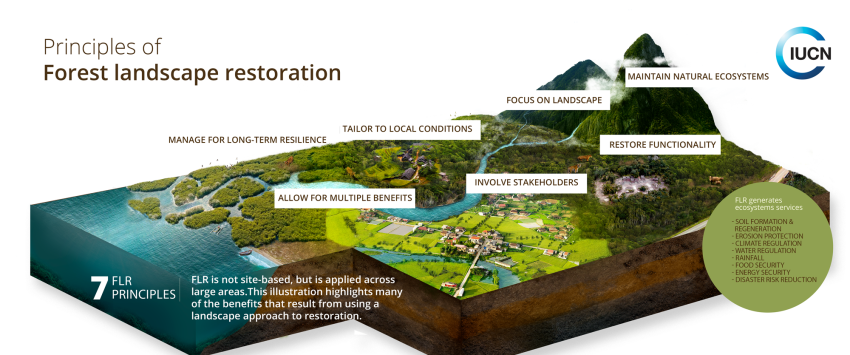FLR manifests through different processes such as: new tree plantings, managed natural regeneration, agroforestry, or improved land management to accommodate a mosaic of land uses, including agriculture, protected wildlife reserves, managed plantations, riverside plantings and more.
According to a global assessment of restoration potential, there are more than two billion hectares of deforested and degraded land around the world where opportunities for some type of restoration intervention may be realised. Restoring forests and forest landscapes is an important step in regaining the health and functionality of these ecosystems.
IUCN collaborates with FLR partners to gather knowledge, develop and apply tools, and build capacity while supporting policy-makers, practitioners, researchers and landowners around the world. IUCN and WRI have also developed a proven Restoration Opportunities Methodology Assessment (ROAM) with practical steps for diverse stakeholders to restore landscapes at any scale.
Guiding principles of forest landscape restoration
 Photo: IUCN
Successful FLR is forward-looking and dynamic, focussing on strengthening the resilience of landscapes and creating future options to adjust and further optimise ecosystem goods and services as societal needs change or new challenges arise. It integrates a number of guiding principles, including:
Photo: IUCN
Successful FLR is forward-looking and dynamic, focussing on strengthening the resilience of landscapes and creating future options to adjust and further optimise ecosystem goods and services as societal needs change or new challenges arise. It integrates a number of guiding principles, including:
-
Focus on landscapes – FLR takes place within and across entire landscapes, not individual sites, representing mosaics of interacting land uses and management practices under various tenure and governance systems. It is at this scale that ecological, social and economic priorities can be balanced.
-
Maintain and enhance natural ecosystems within landscapes – FLR does not lead to the conversion or destruction of natural forests or other ecosystems. It enhances the conservation, recovery, and sustainable management of forests and other ecosystems.
-
Engage stakeholders and support participatory governance – FLR actively engages stakeholders at different scales, including vulnerable groups, in planning and decision making regarding landuse, restoration goals and strategies, implementation methods, benefit sharing, monitoring and review processes.
-
Tailor to the local context using a variety of approaches – FLR uses a variety of approaches that are adapted to the local social, cultural, economic and ecological values, needs, and landscape history. It draws on latest science and best practice, and traditional and indigenous knowledge, and applies that information in the context of local capacities and existing or new governance structures.
-
Restore multiple functions for multiple benefits – FLR interventions aim to restore multiple ecological, social and economic functions across a landscape and generate a range of ecosystem goods and services that benefit multiple stakeholder groups.
-
Manage adaptively for long-term resilience – FLR seeks to enhance the resilience of the landscape and its stakeholders over the medium and long-term. Restoration approaches should enhance species and genetic diversity and be adjusted over time to reflect changes in climate and other environmental conditions, knowledge, capacities, stakeholder needs, and societal values. As restoration progresses, information from monitoring activities, research, and stakeholder guidance should be integrated into management plans.
For more on forest landscape restoration


